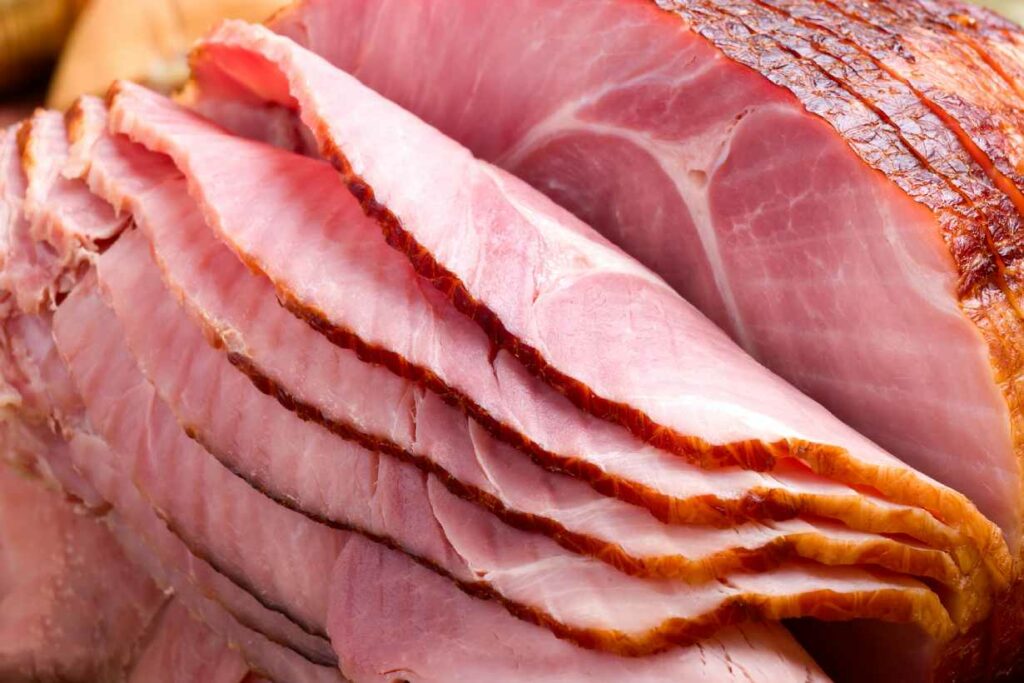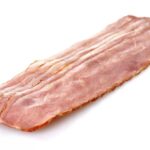Ham, a type of cured meat that comes from the hind leg of pork, enjoys widespread popularity.
However, is ham a healthy choice?
This article delves into the nutritional properties of ham and examines research findings from scientific studies to answer the question.
What Is Ham?

Made from hind pork leg, ham typically undergoes curing and may also undergo smoking or aging processes.
While some traditional hams might exclusively rely on salt for curing, it is more commonplace for ham to incorporate preservatives like sodium nitrate and nitrite.
In the curing process, ham can be either dry-cured or wet cured in a brine solution. Following this, the ham may undergo smoking or aging, both contributing to the development of distinct flavors.
Versatile in nature, ham finds its way into numerous dishes. One of the most common uses of ham involves a large roasted ham complemented by an array of vegetables.
Additionally, sliced ham is a popular ingredient in sandwiches and cheese platters, also serving as a popular ingredient or topping in dishes like pasta and pizza.
Numerous ham products are precooked and ready-to-eat. However, this is not the case universally, and some may be raw or only partially cooked.
In this regard, it is important to check product labels and adhere to instructions for proper cooking, consumption, and storage of ham.
Classified as a type of red meat due to its myoglobin content, which imparts the meat’s reddish hue, ham may be excluded from certain diets based on ethical or religious beliefs, with some religions forbidding pork consumption (1, 2).
Ham Is High In Protein
Let’s begin by examining some of the positives; like most meat products, ham provides a significant amount of protein.
According to USDA data, the lean segment of roasted ham offers 25 grams of protein per 100 grams by weight (3).
Furthermore, this 100 gram provision of ham only contains 157 calories.
For individuals aiming to boost their protein intake without introducing excessive calories, ham stands out as one of the most protein-dense foods.
Protein is important for muscle growth and repair, playing a crucial role in various vital functions. These protein-assisted functions include the production of enzymes, hormonal regulation, and supporting the immune system (4, 5).
Contains a Broad Range of Essential Vitamins and Minerals
Beyond its protein content, ham is abundant in various essential nutrients.
In a 100-gram serving of roasted ham, one can obtain more than 20% of the recommended daily value for (3, 6):
- Thiamin (vitamin B1)
- Riboflavin (vitamin B2)
- Niacin (vitamin B3)
- Vitamin B6
- Vitamin B12
- Selenium
- Zinc
As evident from the above list, ham is an outstanding source of B vitamins, additionally offering good amounts of selenium and zinc.
Moreover, several other essential nutrients are present at levels surpassing 10% of the daily value.
Ham Is Typically High In Sodium
On the downside, ham products are typically high in sodium.
According to USDA data, a 100-gram serving of roasted ham typically supplies 1327 mg of sodium. This amount surpasses more than half (55.3%) of the daily value for sodium, which stands at 2300 mg (3, 6).
In this regard, excessive sodium intake can lead to an increased risk of developing elevated blood pressure. High blood pressure, also known as hypertension, is a major risk factor for cardiovascular disease (7, 8, 9, 10).
Given that ham ranks among the most sodium-rich foods, it may not be suitable for everyone. For example, individuals with high blood pressure who are carefully monitoring their sodium intake may need to limit or restrict their consumption of ham.
Preservatives: Ham Is Often Preserved With Sodium Nitrate and Nitrite
When evaluating the healthfulness of ham, a crucial aspect to consider is its ingredient profile.
While certain traditional ham products may omit them, a majority of commercial ham products list sodium nitrate or sodium nitrite among their ingredients.
These preservatives find widespread use in processed meats, helping to prevent spoilage, extend shelf life, and enhance flavor. Sodium nitrate and nitrite are not ingredients exclusive to ham, and they are also present in other processed meats like bacon, sausages, and spam.
However, a concern is that sodium nitrate and nitrite can convert to nitrosamines, either during the cooking process or within the body. This conversion happens when nitrites react with amines, which are derivatives of ammonia found in protein-rich foods (11, 12).
Nitrosamines are known carcinogens, and multiple studies have highlighted a link between a high intake of processed meat and an elevated risk of cancer (13, 14, 15, 16).
Taking this evidence into consideration, the World Health Organization’s International Agency for Research on Cancer (IARC) classified processed meat as a ‘Group 1 carcinogen’ in 2015. The organization asserted that “processed meat was classified as carcinogenic to humans, based on sufficient evidence in humans that the consumption of processed meat causes colorectal cancer” (17).
However, it is essential to note that the individual risk of developing colorectal cancer from processed meat was deemed “small.” On this note, the data informing IARC’s findings indicated that each 50-gram portion of daily processed meat increased the risk by 18% (18).
Moreover, it’s crucial to understand that this ‘18%’ figure pertains to relative risk rather than absolute risk. In simpler terms, it signifies an increased risk compared to individuals who consume no processed meat.
What Is the Full Nutritional Profile of Ham?
The nutritional profile of roasted ham per 100 grams is presented in the following tables.
The data source is the USDA’s FoodData Central, and daily values have been computed using the FDA’s recommended values (3, 6).
| Name | Amount | % Daily Value |
|---|---|---|
| Calories | 157 kcal | |
| Carbohydrates | 0 g | 0% |
| Fiber | 0 g | 0% |
| Sugars | 0 g | |
| Fat | 5.5 g | 7.1% |
| Saturated | 1.84 g | 9.2% |
| Monounsaturated | 2.53 g | |
| Polyunsaturated | 0.63 g | |
| Omega-3 | 0.06 g | |
| Omega-6 | 0.5 g | |
| Protein | 25.0 g | 50% |
| Cholesterol | 55 mg | 18.3% |
As indicated by the table, the lean sections of roasted ham are relatively low in calories while delivering a substantial amount of protein.
Ham contains a moderate amount of fat in ham, primarily consisting of monounsaturated fat, with a slightly lower quantity of saturated fat.
The polyunsaturated fat content is on the lower side.
However, it is worth noting that fattier cuts of ham can have a significantly higher fat content.
Vitamins
| Vitamin | Amount | % Daily Value |
|---|---|---|
| Choline | 102 mg | 18.5% |
| Folate, DFE | 4 mcg | 1.0% |
| Vitamin A, RAE | 0 mcg | 0% |
| Vitamin B1 (thiamin) | 0.68 mg | 56.7% |
| Vitamin B2 (riboflavin) | 0.254 mg | 19.5% |
| Vitamin B3 (niacin) | 5.02 mg | 31.4% |
| Vitamin B5 (pantothenic acid) | 0.498 mg | 10.0% |
| Vitamin B6 | 0.47 mg | 27.6% |
| Vitamin B12 | 0.7 mcg | 29.2% |
| Vitamin C | 0 mg | 0% |
| Vitamin D | 0.9 mcg | 4.5% |
| Vitamin E | 0.26 mg | 1.7% |
| Vitamin K | 0 mcg | 0% |
Minerals
| Mineral | Amount | % Daily Value |
|---|---|---|
| Calcium | 7 mg | 0.5% |
| Copper | 0.087 mg | 9.7% |
| Iron | 0.94 mg | 5.2% |
| Magnesium | 22 mg | 5.2% |
| Manganese | 0.016 mg | 0.7% |
| Phosphorus | 227 mg | 18.2% |
| Potassium | 316 mg | 6.7% |
| Selenium | 25.4 mcg | 46.2% |
| Sodium | 1330 mg | 57.8% |
| Zinc | 2.57 mg | 23.4% |
Is Ham a Healthy Choice?
When contemplating the question of whether ham is a healthful choice, there are two primary questions we should ask:
- Compared to what?
- As part of what kind of diet?
The Comparator Is Important
When assessing the healthfulness of a particular food, we must consider the question: “compared to what?”
This is crucial because, given the necessity to eat, our food choices ultimately come down to opting for one option over another. With this perspective in mind, let’s compare ham to various protein-rich foods.
Is ham a healthy choice when compared to regular, unprocessed pork leg?
In this context, a fair answer would be no, as unprocessed pork leg is the same type of meat but without the high sodium levels and preservatives found in ham.
Is ham a healthy choice compared to salmon?
Again, it would be challenging to argue against salmon being a healthier choice. Salmon provides similar protein content, a source of omega-3, and lacks the preservative and high-sodium content associated with ham.
Is ham a healthy choice compared to a bacon cheeseburger?
Now, if we assess ham against a bacon cheeseburger, the argument for ham being a healthier choice is more plausible. Both foods contain high levels of salt and preservatives, but the burger would also be a source of refined carbohydrates and have a considerably higher calorie count.
Moreover, in such a scenario, the bacon cheeseburger might typically be served alongside fries and cola too, which comes to the next crucial point: the overall diet.
The Overall Diet Matters
When determining whether ham can fit into a healthy diet, we also have to consider what it is consumed alongside. For instance, can a weekly serving of roast ham, paired with potatoes and vegetables, fit into a healthy dietary pattern? Certainly.
In contrast, would a daily routine of ham sandwiches for lunch and a ham and cheese pizza for dinner qualify as a healthy dietary pattern? No.
In another scenario, one could argue that blueberries stand above ham in terms of healthfulness. However, if an individual had an insufficient protein intake to meet their needs, ham would be better for fulfilling their dietary requirements.
Rather than fixating on any single food or meal, it is the overall dietary pattern that dictates long-term health outcomes. To put it another way, it is the overall diet that matters most, and a sensible, well-formulated diet can accommodate all foods.
Final Thoughts
Ham offers a diverse range of essential nutrients and a high protein content.
However, there are concerns surrounding its high sodium and preservative content, which are issues absent in unprocessed meat.
In this context, ham is a food where portion size moderation and being aware of its sodium content is important.
That said, as with most foods, for individuals that enjoy ham, it can fit into a healthful dietary pattern.








